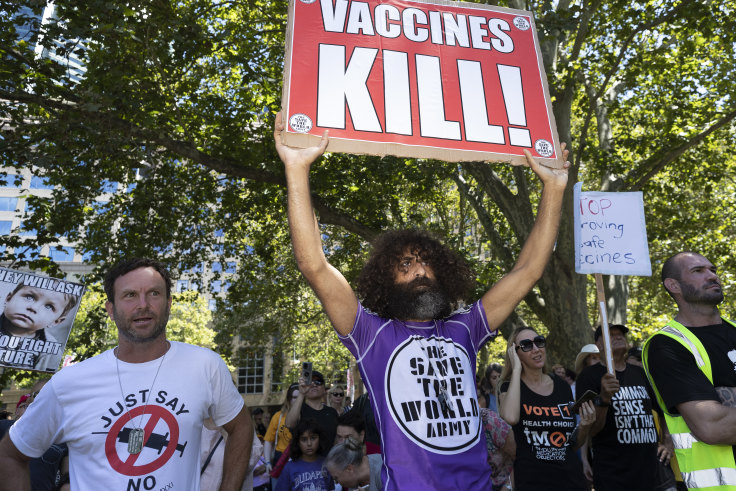Protests against vaccines at Sydney, Australia. February 2021.
Ever since the world has been introduced to COVID-19 vaccines, the swarm of anti-vaxxers has resurfaced.
But first, how do vaccines work? Well, vaccines contain weaker parts of a virus that strengthen our immune system and help the body create the instructions used to fight a disease. Some vaccines require more doses, days, weeks, or even months apart.
Vaccines have been in use as early as the 18th century, thanks to Edward Jenner, a scientist who is credited for the discovery and development of vaccines. While observing milkmaids working in a farm, Jenner was intrigued by how they didn’t catch smallpox like others did. Jenner went through a series of experiments and landed with the discovery of how pus could benefit humans. He scraped it from sick cows onto the skin of his family members, and, to his surprise, they didn’t get sick. This led to the smallpox vaccine, which became the first to successfully eradicate an infectious disease.
Jenner’s discovery was immediately met with backlash. But can we really blame the public for responding like this? This discovery was made in a time when the public wasn’t open to new ideas and innovation, since many lacked general education, were illiterate, and had enormously varying levels of comprehension.
In modern day, however, the anti-vax movement makes no sense.
We live in a digital era where the internet is far more accessible and contains all sorts of information. To find reliable sources is not difficult unless you’re prone to read from unreliable or unverified sources. On top of that, the science behind vaccines has rapidly advanced, and there is endless research that proves the credibility of vaccines.
One of the most well known myths about vaccines is that they cause autism. The stigma of vaccines being linked to autism is due to the 1998 paper authorized by Andrew Wakefield. The study claimed that children who were vaccinated with the MMR vaccine would contract the disorder.
A group of researchers and doctors conducted a study known as the Wakefield Study, where 12 children presented themselves at a hospital. Wakefield noted that the children had developmental issues, the most common one being autism. The children’s families were interrogated about their children’s issues, specifically when the symptoms of these issues first appeared. The majority of them recalled that the child’s symptoms appeared after being vaccinated with the MMR vaccine.
The biggest flaw of this study is that the claims weren’t rooted in much evidence. What many of the parents didn’t consider is that autism is a lifelong developmental disorder that is impossible to contract after birth. Additionally, the study was criticized drastically for having no controls, linking three common conditions, and utilizing anecdotal evidence from parents rather than objective data. Wakefield’s stance on this issue has drastically changed in the past few years, and he has strayed away from his initial claims due to the lack of evidence. Despite his change in stance, an immeasurable amount of damage has been done.
Ignorance is the biggest epidemic. Time periods may have changed, but anti-vaxxers are still here. As of now, 54.3% of the US population has been fully vaccinated from COVID-19. Despite the easy accessibility, many have refused to get vaccinated due to their beliefs, which are often rooted in philosophy, politics, and even spirituality. Meanwhile, those who want, or have been vaccinated, most likely have a decent understanding of how the vaccine works, and want to protect themselves from common viruses.
Hopefully, this movement with obvious fallacies will come to an end so that we can take advantage of the technology we have and protect ourselves from curable diseases. If not, we are throwing away centuries worth of research.
Works Cited
BMJ. “Wakefield’s article linking MMR vaccine and autism was fraudulent.” The BMJ. 2011.
https://www.bmj.com/content/342/bmj.c7452.
“Debunking Anti-Vaxxers.” YouTube, uploaded by AsapSCIENCE, 15 February 2018,
https://www.youtube.com/watch?v=b03U6BYF9L0.
Haelle, Tara. “Vaccine hesitancy is nothing new. Here’s the damage it’s done over centuries.” Science News. 11 May 2021.
https.//www.sciencenews.org/article/vaccine-hesitantcy-history-damage-anti-vaccination.
“How do vaccines work?” World Health Organization. 8 December 2020.
Ianelli, Vincent. “History of the Anti-Vaccine Movement From the 18th Century to the COVID-19 Pandemic.” Very Well Health. 03 June 2021.
https://www.verywellhealth.com/history-anti-vaccine-movement-4054321.
“Lancet retracts 12-year-old article linking autism to MMR vaccines.” NCBI. 9 March 2010.
https://www.ncbi.nlm.nih.gov/pmc/articles/PMC2831678/.
Ritchie, Hannah. “Coronavirus (COVID-19) Vaccinations.” Our World in Data. 2021.
https://ourworldindata.org/covid-vaccinations?country=USA.
“The origins of the anti-vaccine movement.” YouTube, uploaded by Vox, 12 February 2015,

